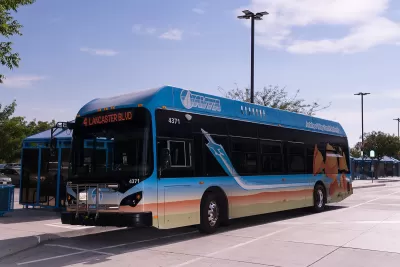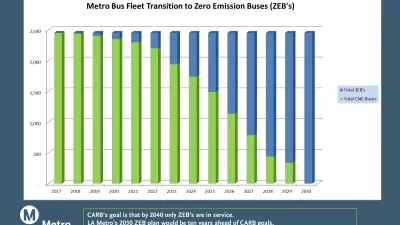Smaller transit systems may be effectively positioned to take the lead in electrifying their fleets and bringing electric vehicles to a wider range of communities.

A transit operator in a desert community north of Los Angeles "celebrated a milestone last month no other transit agency in the country can claim: the first fleet to be fully electrified, hitting its zero-emission goal a full 18 years earlier than scheduled." As Alissa Walker reports, the Antelope Valley Transit Authority now boasts 77 electric buses and ten electric microtransit vans.
While big-city transit agencies are still years or decades away from electrifying their fleets — the MTA is aiming for full electrification by 2040; L.A. County’s Metro is hoping for 2030 — the Antelope Valley, a region of about 450,000 people, got there long before anyone else.
According to Walker, "There are hundreds of midsize cities like these across the U.S., and this is where the electrification revolution can start. The big cities will be the ones playing catch-up."
AVTA's success story, Walker says, provides a "glimpse at what's possible" as more federal and state funding is directed to electrification efforts. "In California, a majority of the people who have access to electric vehicles live in a handful of wealthy Zip Codes. What’s happening in the Antelope Valley flips that, delivering electrification to the communities severed by trucking routes and suffering from bad air."
FULL STORY: The Electrification Revolution Can Start in Smaller Cities

Study: Maui’s Plan to Convert Vacation Rentals to Long-Term Housing Could Cause Nearly $1 Billion Economic Loss
The plan would reduce visitor accommodation by 25,% resulting in 1,900 jobs lost.

North Texas Transit Leaders Tout Benefits of TOD for Growing Region
At a summit focused on transit-oriented development, policymakers discussed how North Texas’ expanded light rail system can serve as a tool for economic growth.

Why Should We Subsidize Public Transportation?
Many public transit agencies face financial stress due to rising costs, declining fare revenue, and declining subsidies. Transit advocates must provide a strong business case for increasing public transit funding.

How to Make US Trains Faster
Changes to boarding platforms and a switch to electric trains could improve U.S. passenger rail service without the added cost of high-speed rail.

Columbia’s Revitalized ‘Loop’ Is a Hub for Local Entrepreneurs
A focus on small businesses is helping a commercial corridor in Columbia, Missouri thrive.

Invasive Insect Threatens Minnesota’s Ash Forests
The Emerald Ash Borer is a rapidly spreading invasive pest threatening Minnesota’s ash trees, and homeowners are encouraged to plant diverse replacement species, avoid moving ash firewood, and monitor for signs of infestation.
Urban Design for Planners 1: Software Tools
This six-course series explores essential urban design concepts using open source software and equips planners with the tools they need to participate fully in the urban design process.
Planning for Universal Design
Learn the tools for implementing Universal Design in planning regulations.
Ascent Environmental
Borough of Carlisle
Institute for Housing and Urban Development Studies (IHS)
City of Grandview
Harvard GSD Executive Education
Toledo-Lucas County Plan Commissions
Salt Lake City
NYU Wagner Graduate School of Public Service





























